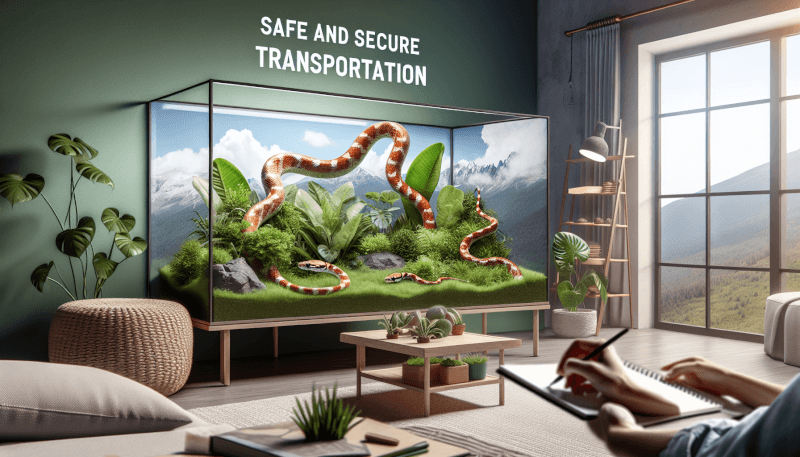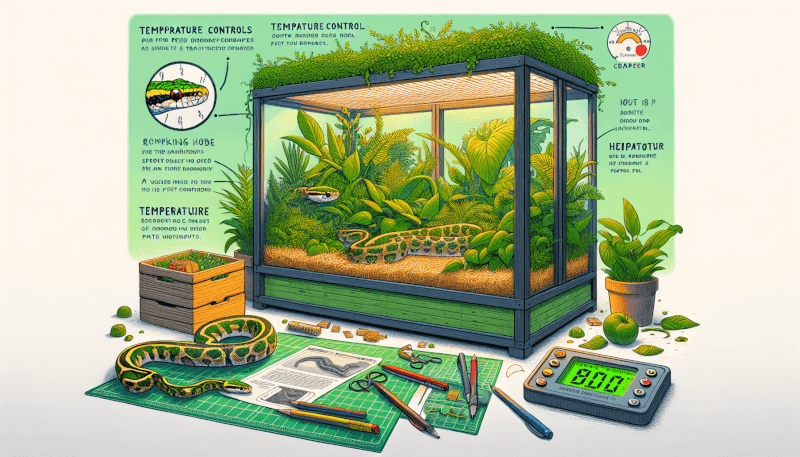Whether you’re moving to a new home or taking your pet snake on a road trip, ensuring a safe and secure travel environment is crucial. Pet snakes require specific conditions to stay comfortable and stress-free during travel, which can sometimes be a daunting task. From temperature regulation to preventing escape, this article will provide you with essential tips and tricks to ensure a smooth and worry-free journey for your slithering companion. So, get ready to hit the road with your scaly friend and make their travel experience as safe and secure as possible.

Choosing the Right Carrier
Size of the carrier
When it comes to choosing the right carrier for your pet snake, size matters. You want to make sure that the carrier is spacious enough for your snake to move around comfortably, but not too large that it poses a risk of injury during travel. A good rule of thumb is to select a carrier that is at least one and a half times the length of your snake.
Material of the carrier
The material of the carrier is another important consideration. Opt for a carrier that is sturdy and durable, such as a plastic or acrylic carrier. It’s essential to choose a carrier that is escape-proof, as snakes are known for their ability to squeeze through small openings. Additionally, the carrier should be easy to clean and sanitize, as hygiene is crucial for both your snake’s health and your own.
Ventilation and visibility
Proper ventilation is vital to ensure a safe and comfortable environment for your pet snake during travel. Look for a carrier that has sufficient airflow to prevent overheating or lack of oxygen. It is also beneficial to select a carrier that provides good visibility, allowing your snake to see its surroundings and reducing any feelings of confinement or stress.
Security features
When selecting a carrier, it is essential to choose one that has secure locking mechanisms. This will prevent accidental openings and ensure that your snake remains safely contained throughout the journey. Additionally, consider carriers with built-in handles or straps to make transportation more convenient and secure.
Preparing the Carrier
Cleaning the carrier
Before embarking on your journey, it is crucial to clean the carrier thoroughly. Start by removing any bedding or debris from the carrier, using gloves if necessary. Wash the carrier with warm water and a mild pet-safe detergent, ensuring you rinse it thoroughly to remove any residue. Finally, allow the carrier to air dry completely before adding any bedding or your snake.
Creating a comfortable bedding
Providing a comfortable bedding is essential for your snake’s well-being during travel. Choose a substrate that mimics their natural habitat, such as aspen shavings or reptile-safe paper bedding. Avoid using materials like cedar or pine, which can be harmful to reptiles. Ensure that the bedding is deep enough for your snake to burrow and feel secure during the journey.
Adding hiding spots
Snakes are naturally inclined to seek shelter in small, enclosed spaces, especially during times of stress. To make the carrier more comfortable, consider adding hiding spots, such as small caves or artificial plants. These hiding spots will give your snake a sense of security and help minimize stress during travel.
Ensuring proper temperature and humidity levels
Maintaining proper temperature and humidity levels is crucial for your snake’s health and well-being during travel. Before placing your snake in the carrier, ensure that it is in a temperature-controlled environment and that the carrier provides adequate insulation. Additionally, consider using a small, battery-powered thermometer and hygrometer to monitor and maintain the optimal temperature and humidity levels throughout the journey.

Transporting the Snake
Handling the snake
When transporting your snake, it is important to handle them with care and gentleness. Snakes can become stressed and agitated if mishandled, which can lead to injury or sickness. Approach your snake calmly and confidently, using both hands to support its body and avoid sudden movements.
Using a snake hook or tongs
If you are uncomfortable handling your snake directly, consider using a snake hook or tongs. These tools allow you to safely and securely guide your snake into the carrier without risking any accidental bites or injuries. Remember to use gentle and controlled movements when using these tools to avoid causing any harm or unnecessary stress to your snake.
Avoiding sudden movements
Snakes are sensitive to vibrations and sudden movements, which can startle and stress them. When transporting your snake, avoid any sudden or jerky motions that could jostle the carrier. This will help keep your snake calm and prevent unnecessary stress or discomfort during the journey.
Securing the carrier in the vehicle
To ensure the safety of your snake during transportation, make sure the carrier is securely fastened in the vehicle. Place the carrier in a well-ventilated and stable area, such as the backseat or trunk, and secure it using seat belts or other restraints if necessary. Avoid placing the carrier near any hot or cold air vents to maintain a comfortable temperature for your snake.
Legal Considerations
Checking local regulations
Before traveling with your pet snake, it is essential to check local regulations regarding the transportation of exotic animals. Some areas may have specific laws or restrictions on keeping and transporting snakes. Research the regulations for your departure point, any connecting cities, and your final destination to ensure compliance throughout your journey.
Obtaining necessary permits or licenses
In some cases, you may need to obtain permits or licenses to transport your snake legally. Contact the appropriate authorities or local government agencies to inquire about any necessary documentation required for transporting your snake. Failure to comply with these regulations could result in legal consequences or confiscation of your pet.
Ensuring compliance with transportation laws
In addition to local regulations, it is important to ensure compliance with transportation laws. Different modes of transportation, such as airlines or trains, may have specific rules or guidelines regarding the transportation of animals. Familiarize yourself with these regulations and make arrangements accordingly to avoid any complications during your journey.

Emergency Preparedness
Carrying necessary medications or first-aid supplies
When traveling with your pet snake, it is always prudent to carry necessary medications or first-aid supplies in case of emergencies. Consult with a veterinarian to determine if there are any specific medications or supplies your snake may require during travel. Be prepared for any potential emergencies by having the appropriate supplies readily available.
Knowing emergency contact information
Before embarking on your journey, ensure you have the contact information for an emergency veterinarian or a local herpetologist who specializes in snake care. In the event of an emergency or unexpected health issue with your snake, having this contact information readily available can save valuable time and potentially save your pet’s life.
Having a backup plan in case of emergencies
In case of unforeseen circumstances, such as a flight delay or a vehicle breakdown, it is important to have a backup plan in place. Research nearby pet-friendly accommodations or veterinary clinics along your travel route. This will allow you to quickly make alternative arrangements should an emergency or unexpected delay occur.
Health and Hygiene
Regular health check-ups
Maintaining your snake’s health and well-being is crucial, especially during travel. Schedule regular health check-ups with a veterinarian experienced in reptile care. These check-ups will help ensure that your snake is in good health and can handle the stress of travel. The vet can also provide any necessary vaccinations or preventative treatments.
Keeping the carrier clean and sanitized
A clean and sanitized carrier is paramount for your snake’s well-being. Regularly clean the carrier between uses, removing any soiled bedding or debris. Wash the carrier with warm water and a reptile-safe detergent, being sure to rinse it thoroughly and allow it to air dry completely. This will help prevent the buildup of bacteria or parasites that can be harmful to your snake’s health.
Preventing the spread of diseases
To minimize the risk of spreading diseases, it is essential to practice proper hygiene when handling your snake and its carrier. Wash your hands thoroughly before and after handling your snake, and avoid handling other animals or their equipment before handling your snake. This will help prevent cross-contamination and minimize the risk of introducing harmful pathogens to your snake.
Maintaining proper hygiene
Maintaining proper hygiene within your snake’s carrier is crucial for their health and well-being. Regularly remove any soiled bedding, uneaten food, or shed skin from the carrier. Be sure to clean and sanitize any food and water dishes between uses to prevent the growth of harmful bacteria. By practicing good hygiene, you can help minimize the risk of infections or illnesses for your snake.

Minimizing Stress
Using familiar objects or scents
Snakes are creatures of habit and appreciate familiarity. To help minimize stress during travel, consider placing familiar objects, such as hides or decorations from their enclosure, in the carrier. You can also add a small cloth or bedding with your snake’s scent to provide comfort and familiarity during the journey.
Playing calming music
Music has a soothing effect on many animals, including snakes. Playing soft and calming music during the journey can help reduce stress and provide a more relaxing environment for your snake. Choose music without sudden or loud changes and ensure that the volume is not too loud as to startle your pet.
Avoiding loud noises or bright lights
During travel, it is important to minimize exposure to loud noises or bright lights, as these can be stressful for your snake. Avoid areas with high levels of noise, such as crowded airports or busy highways, whenever possible. Keep the carrier in a shaded or dimly lit area to provide a calm and serene environment for your snake.
Maintaining a consistent routine
Snakes thrive on routine, and disruptions to their daily schedule can be stressful. To minimize stress during travel, try to maintain a consistent routine as much as possible. Stick to regular feeding and watering schedules and provide your snake with the same amount of light and darkness they are accustomed to. This will help provide a sense of familiarity and stability for your snake during the journey.
Monitoring and Observation
Keeping an eye on the snake
Throughout your journey, it is important to keep a close eye on your snake. Regularly check on your snake’s condition, ensuring they are comfortable and not displaying any signs of distress. Pay attention to their breathing, body language, and overall behavior. This will allow you to address any potential issues promptly and ensure the well-being of your pet.
Watching for signs of distress or illness
During travel, your snake may exhibit signs of distress or illness. Monitor for changes in behavior, such as excessive hiding, lack of appetite, or increased aggression. Additionally, watch for physical signs of illness, such as abnormal skin coloration, discharge from the mouth or eyes, or difficulty breathing. If you notice any concerning symptoms, seek veterinary attention as soon as possible.
Monitoring temperature and humidity
Maintaining proper temperature and humidity levels within the carrier is essential for your snake’s health. Regularly check the temperature and humidity using a thermometer and hygrometer. Make adjustments as necessary to ensure that the carrier remains within the optimal range for your snake’s species. This will help promote a comfortable and stress-free environment during travel.
Observing behavioral changes
Pay close attention to your snake’s behavior and note any changes. Travel can be stressful for snakes, and they may exhibit different behaviors or reactions in response to this stress. Note any changes in activity levels, feeding habits, or interactions with their environment. By observing these behavioral changes, you can identify potential stressors and adjust accordingly to ensure your snake’s well-being.

Preparing for Destinations
Researching accommodation options
If you are traveling overnight or for an extended period, it is crucial to research accommodation options that are snake-friendly. Not all hotels or rental properties allow pets, especially exotic animals like snakes. Look for accommodations that have a pet-friendly policy and are willing to accommodate reptiles. Contact the establishment ahead of time to confirm their policy and any specific requirements.
Informing airlines or other transportation providers
If you are traveling by air or using any other transportation provider, it is essential to inform them in advance about your pet snake. Airlines and other transportation providers may have specific guidelines or requirements for traveling with pets, including the need for additional documentation or the use of specific carriers. Keep in mind that some airlines may have restrictions on transporting snakes, so it is crucial to inform yourself beforehand.
Checking destination-specific regulations
Just as you checked local regulations before departure, it is equally important to check the regulations at your destination. Research any specific rules or guidelines regarding the transportation and ownership of snakes in the area you are traveling to. This will help you ensure compliance and avoid any legal issues or complications upon arrival.
Ensuring snake-friendly environments
Before reaching your destination, take the time to ensure that the environment you are bringing your snake into is safe and suitable. Remove any potential hazards, such as toxic plants or objects that could pose a risk to your snake’s health. Set up the enclosure in a quiet area away from high-traffic areas or where other pets can access it. By creating a snake-friendly environment, you can ensure a smooth transition for your pet.
Traveling Abroad
Researching import and export requirements
Traveling abroad with a pet snake requires additional research and preparations. Each country has its own import and export requirements for pets, including snakes. Research the specific regulations for the destination country, including any necessary permits or paperwork needed for the transport of your snake.
Obtaining necessary vaccinations or health certificates
Some countries may require your snake to be vaccinated or possess certain health certificates before entry. Consult with a veterinarian experienced in international travel to determine if your snake requires any vaccinations or health certificates. Schedule these appointments well in advance of your travel dates to ensure compliance with all necessary regulations.
Preparing for customs inspections
Traveling with a pet snake internationally may involve customs inspections upon arrival. Be prepared for these inspections by having all necessary paperwork and permits readily available. Familiarize yourself with the specific requirements of each country’s customs department to ensure a smooth entry process for your snake.
Understanding quarantine regulations
Certain countries may have quarantine regulations for animals entering their borders. This means that your snake may be required to undergo a period of quarantine upon arrival. Research the quarantine regulations for your destination country and plan accordingly to ensure your snake’s well-being during this period.
In conclusion, ensuring a safe and secure travel environment for your pet snake involves careful planning, preparation, and attention to detail. By choosing the right carrier, preparing the carrier appropriately, and following legal considerations, you can create a comfortable and stress-free travel experience for your snake. Additionally, practicing good hygiene, minimizing stress, and monitoring your snake’s well-being throughout the journey will help ensure a successful trip. Whether traveling domestically or internationally, take the necessary steps to ensure compliance with all regulations and requirements. With proper planning and care, you can provide your pet snake with a safe and enjoyable travel experience.


